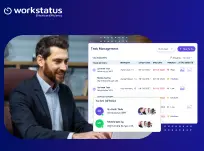Table of Contents
Artificial Intelligence (AI) is moving up the business value chain, with businesses recognizing its potential to assist in workforce management and planning.
Organizations are turning to automation to remain competitive in the new economy to eliminate manual effort and replace it with more efficient processes driven by artificial intelligence. They’re also looking for methods to utilize AI better to improve how they use employee data.
As per Gartner’s research, it is anticipated that by 2023, 60% of large businesses will have implemented digital transformation projects to automate HCM administration (HCM) activities.
By 2025, 60% of large businesses and mid-size firms will be using cloud-deployed HCM suites for administrative and talent management.
However, even if you remove these gaps entirely using HR software, most organizations will still need to get 20-30% of their HCM needs from other solutions.
Most of the invested money will be used for the company’s fundamental HR administration, HR service management (HRSM), talent management, and workforce management functions.
However, business executives are actively engaged in determining how to properly analyze and exploit the data that is accessible through their HCM platforms, particularly in terms of operational planning from a financial modeling standpoint.
Many company executives could not have foreseen the global coronavirus pandemic’s wide-scale challenges. However, the significant changes in how employees must operate have shed light on the necessity of optimizing efficiency in everything from staff to data and forecasting processes within corporate workforce planning.
The rapid growth of AI in the public sector recognizes that more efficiency can be gained from services by deploying this technology. As digital transformation projects begin to supercharge the shift towards a ‘predictive’ capability in forecasting and planning, many organizations are confronted with the twin challenges of finding the appropriate data science and analytics talent to drive these initiatives forward and incorporating AI-assisted processes into their existing workflows.
Read the full blog to know how AI can change the face of WFM in 2021-
How Is AI Leading Workforce Management?
AI is the new buzzword in almost every industry, and workforce management (WFM) is no exception. Its ability to analyze massive amounts of data and automate simple tasks can potentially change the way many WFM processes work.
AI will manage workforce planning, scheduling, timekeeping, and performance management.
1. AI can help with workforce planning
In the past, workforce planning was primarily a manual process that involved looking at data such as hiring plans, employee attrition rates, and business forecasts to predict future staffing needs.
However, this process can be improved with the help of AI.
AI can analyze historical data to identify patterns and trends. It can also use predictive analytics to predict future needs based on current data. This helps organizations plan their workforce more effectively and ensure that they have the correct number of employees at the right time.
Also read: 7 Leadership Tips for Digital Workforce Management
2. AI can help with scheduling
Employee scheduling is one of the most time-consuming and challenging tasks in WFM. With the help of AI, it can be automated and simplified.
Many organizations are already using machine learning to optimize schedules by analyzing historical data related to employees’ task preferences, availability, skill sets, workflows, and time required for completing tasks.
3. AI can help with timekeeping
Timekeeping is another crucial aspect of WFM. It has previously been accomplished manually by keeping track of employee hours worked.
However, AI can easily automate timekeeping tasks for better productivity and management.
AI can track employee hours worked automatically by reading time logs or attendance records. This helps organizations to save time and money on administrative tasks.
If you are looking for any AI-powered employee monitoring software, consider Workstatus with geofencing capabilities.
4. AI can help with performance management
Performance management is another area that can benefit from the use of AI. With the help of machine learning, one can analyze historical data related to employees’ performance. This helps managers identify areas where high-performing employees excel and low-performing employees need improvement, with minimal bias or subjectivity.
Thus, these are some ways through which AI is leading workforce management.
Machine learning algorithms enable an organization to take all the data about employee performance and develop models that predict future outcomes. This helps organizations identify at-risk employees before they become a problem and make necessary changes to improve their performance.
AI will be used extensively in workforce management to automate simple tasks, analyze data, and predict future needs. This will help organizations run their businesses more effectively and improve the performance of their employees.
Read more: How AI can Detect Employee Violations Quicker Than Ever
What To Expect From An AI-Enabled Workforce Management System?
As Artificial Intelligence (AI) continues to evolve, businesses are looking for ways to incorporate the technology into their operations. One area that is seeing a lot of interest is workforce management.
AI-enabled systems can help organizations optimize their workforce planning and scheduling, improve communication and collaboration, and identify potential issues before they become problems.
AI-enabled workforce management systems will be able to do the following:
- Automatically match workers with the right tasks based on their skills and preferences.
- Recommend task assignments and changes to workers in real-time based on their individual skill sets, work preferences, and job performance.
- Generate reports on worker productivity and task performance.
- Identify areas that need improvement and recommend changes to improve worker efficiency.
- Assist managers in making informed decisions about staffing levels and department restructuring.
- Automate timekeeping and payroll processes.
- Facilitate communication between workers and management.
- Assist in the training and development of workers.
- Help to create a more engaged, productive workforce.
The impact of AI on the workforce management process is clear: it will automate many routine tasks, making the process more efficient and effective.
With the help of AI, managers will be able to make better decisions about their workforce, leading to increased productivity and improved business results.
Which AI-Enabled Tool Is The Best For Workforce Management?
There are many AI-enabled tools available in the market that can make workforce management easier. The best tool for your organization is the one that helps you manage your organization in 360 degrees.
Workstatus, the best workforce management software, includes more than 15 features for employee management and productivity enhancement, giving your organization the power to function like the big 4s of the world.
Here’s how Workstatus can help you. You can also take a live demo to walk through the product more efficiently.
Workstatus is a cloud-based workforce management software that helps firms monitor their employees’ work hours to improve business activities.
It also has features for payroll, tax benefits compliance with labor rules, employment contracts, and HR data security, including password encryption, an audit log, and built-in job costing reports.
Key Features:
- GPS tracking system
- Online timesheets
- Summary reports
- Productivity tracking
- Team scheduling
- Simple Payroll
- Geofencing
- Online invoicing
- Project estimation
- Attendance management
- Task management
Pricing:
- Free Forever Package: ₹0
- Starter Package: ₹366.07/user/month
- Scale Package: ₹732.87/user/month
- Enterprise Package: ₹1320.49/user/month
Overall, Workstatus offers a comprehensive solution for workforce management with various features that cater to businesses of different sizes.
With the help of AI, it can help organizations automate routine tasks, monitor employee productivity, and manage their workforce efficiently.
Final Thoughts
As AI technology continues to evolve, it is becoming increasingly capable of performing tasks that were once exclusively performed by humans.
One area where AI is proving particularly useful is workforce management. AI-powered workforce management software tools can help businesses optimize scheduling, enhance communication and collaboration, and identify potential problems before they become critical issues.
While some may worry that this increased automation may lead to job losses, it’s important to remember that there are also opportunities for those who have the skills to work alongside these new technologies.
If you’re struggling to manage remote employees, AI-powered GPS tracking software could be the solution you need.
Request a free demo to learn more about how this technology can help streamline your workforce management processes.
FAQs
How can AI improve workforce planning and scheduling?
AI can use predictive analytics to forecast future workforce requirements based on historical data, such as sales or customer traffic. This can help managers schedule the right number of employees with the necessary skills, reducing the need for overtime or understaffing.
Additionally, AI-powered scheduling software like Workstatus can automatically adjust schedules in real-time based on unexpected changes, such as sick leave or last-minute staff requests.
Can AI be used for performance management?
Yes, AI can help automate performance management tasks such as performance tracking, goal setting, and feedback delivery.
AI-powered tools like Workstatus can analyze employee data to identify areas where improvement is needed, suggest personalized development plans, and provide managers with insights to help them make informed decisions. AI can also help ensure performance evaluations are objective and fair by minimizing human biases.
An AI form generator can also help you create feedback forms while you are monitoring performance.












